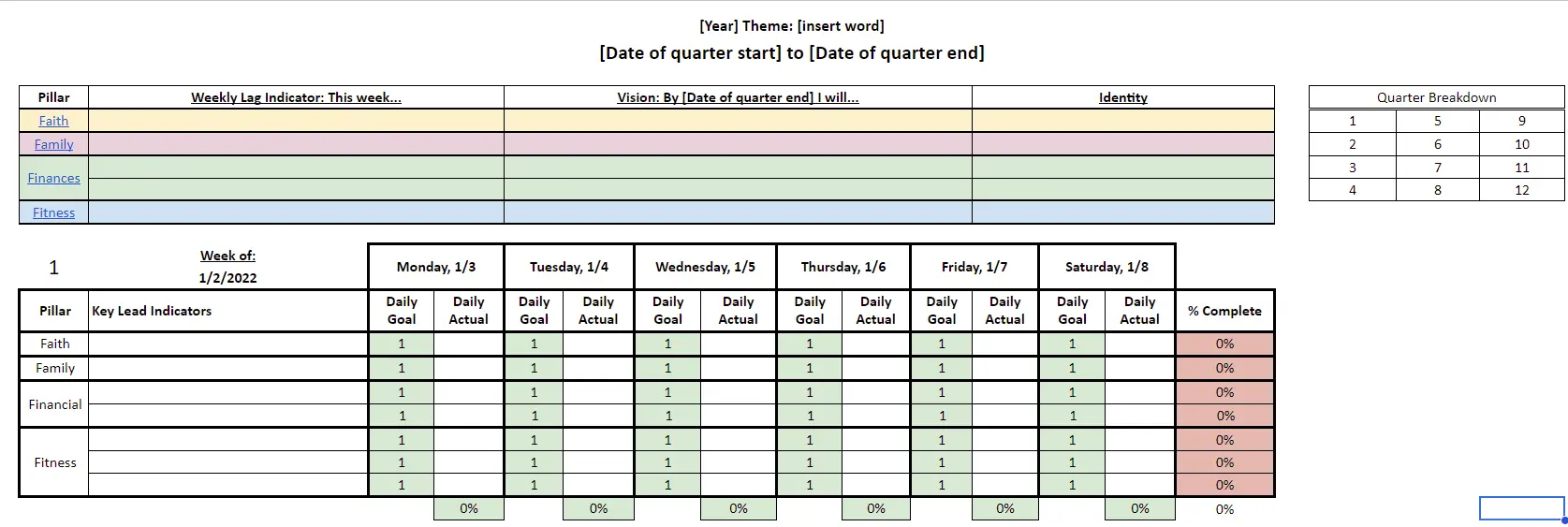Tracking your goals is scientifically proven to make you more likely to achieve them. So you might be wondering, what are some of the best ways to track your goals?
Here are a few of the main ways you can track your goals:
- Google doc
- Pen & paper
- Spreadsheet
- Physical journal
- Goal-tracking app
- Accountability partner
- Notes app on your phone
To find the best one for you, pick one on the list and try it out. Keep refining your method and soon you’ll have an unbeatable goal tracking system.
Start with something easy if you’re new to tracking goals. Or, for those more experienced, you might try something different on this list if you’ve found that your current system doesn’t work well for you.
Whatever your situation, you need to not overthink it and just dive in and start. Oh and if you want to know how to create your own goal tracker, check out this article where I explained multiple ways to do so.
In the rest of this article, we’ll just be going over the four top ways to track goals. That’s because these are the ones that I’ve found to be most effective at helping you take advantage of the power of tracking goals.
Let’s dive right in!
Spreadsheet
I’ve been using a spreadsheet to track my goals for almost four years now. It’s completely altered everything about my goal-setting system for the better. I’ve got more accountability, freedom to modify it as needed, and more.
Here’s a screenshot of just one tab of my tracking spreadsheet:

Here are the main advantages of having a spreadsheet to track your goals:
- Customizability: The ability to adjust columns, add borders, and highlight cells to meet your needs is incredibly useful.
- Organization: If you like things neat and tidy, spreadsheets are for you.
- Automation: With formulas and rules, you can easily pinpoint where you’re not hitting your goals and make adjustments.
- Doesn’t take up space: As opposed to some of the other options on here, digitally tracking your goals doesn’t take up any extra room. You can take your spreadsheet with you anywhere.
This option isn’t for everybody, though. Here are the disadvantages of spreadsheets for keeping track of your goals:
- Complex: Putting together all of the formatting and formulas can be a bit complicated sometimes. There’s definitely a learning curve if you’ve not used a spreadsheet before. In my mind, it’s worth learning though!
- It takes time to set up properly: It took me a few months to get my spreadsheet to a place where it was an effective goal-tracker. And I’m still making modifications all the time.
- Lack of visual appeal: If you like something that looks nice, spreadsheets may not be for you. I’ve found a workaround for this by adjusting fonts and colors on mine so I like the look of it. But there’s only so much you can do for something so analytical.
If you want to try spreadsheets out for yourself, follow this article to learn how to make your own.
Physical Journal
When I first started setting goals at 15 years old, I used a journal to write them down and record my progress. It had its advantages for sure. But eventually, the disadvantages were too great for me to ignore and I had to switch.
Here are a few reasons why journals can still be a great way to track your goals:
- Writing by hand has benefits: Your brain develops better, you’re more creative, and you get massive clarity when writing by hand.
- They look amazing: Most journals you can get look really nice. Looking at your goal journal reminds you of your goals and can provide constant inspiration to work on them.
- A pre-made method for tracking goals: With most goal-setting journals, you don’t have to create your own system, it’s already built into the journal. All you have to do is follow it.
There are a few reasons you might not want to use a journal to track your goals, including:
- Time-consuming: Writing by hand is significantly slower than typing. It also can take more effort to locate your journal and a pen to start recording your progress.
- Accessibility: If you forget your journal at home, you’re out of luck for that day. And imagine what you’d do if you lost it!
- Lack of flexibility: Whether you get a pre-made goal-setting journal or create your own, there are limitations on what they can do. Once you set it up a certain way, or if that’s already done for you, it’s difficult or impossible to change up the way you record your progress.
Depending on your personality, using a journal to track your goals might be the right thing for you. Try it out by getting a simple notebook and turning it into a goal tracker.
The Notes App on Your Phone
This one is a bit unique but I had to add it because of how easily it can help you improve.
A couple of months ago I was having a hard time sticking to my writing habit. This had been going on for a while, and I was getting frustrated that I just couldn’t figure it out despite my other goal-tracking methods.
One day I decided to start a new note on my phone for my writing goal and to record my progress and roadblocks each day. I quickly found that the problem was that I wasn’t preparing to write so the blank screen was overwhelming me and making it easy to quit.
Within just one week, I’d figured out how to stick to this goal that I’d been struggling with for so long, all because of a simple note on my phone.
Open a new note for each of your goals. Use the “title” setting. Write “to record my experiences as I [insert action steps here] to achieve the goal of [insert goal here]. Example:
Health Journal
To record my experiences learning and practicing the principles of diet, exercise, and rest with the goal to get to 12% body fat and improve my stamina for hiking.
While there are advantages and disadvantages to this option, it’s so simple to just add this to whatever method you choose that I’d recommend you do it no matter what your main system of tracking goals is.
App
A lot of people use an app to track their progress on their goals. But I don’t really like it for multiple reasons.
A lot of the time, these are just simple habit trackers that you can create on your own with the other methods we’ve mentioned and you have far more flexibility with those.
They do have their advantages though. Let’s look at a few:
- Automation: With reminders, progress tracking, and notifications, apps are great at automating a lot of the goal-tracking process.
- Convenience: It’s really convenient to be able to just pull out your phone and record your progress at any time throughout the day. You can get this advantage by just using the Notes app, though.
- Visualization & Visual Appeal: A lot of apps look nice and neat. Plus, they often let you see a chart or graph of your progress.
Here are a few more reasons why you might want to think twice before downloading an app to track your goals:
- Cost: To get the best features of tracking apps, you’re going to have to pay.
- Lack of flexibility: As with journals, apps don’t often let you customize your tracking experience. This may be an advantage for you though if you don’t want to have to create it from scratch.
- Reliance on technology: What happens if the app crashes? Or if you go to an area where you don’t have internet? If you need to record your progress and you run into these issues, you’re stuck.
If you think this option might work for you, try it out! Here are some popular options:
- ClickUp
- Habitica
- Coach.me
- Weekdone
- Way of Life
- GoalsOnTrack
Let’s Wrap This Up
In summary, there are multiple ways you can track your goals:
- Google doc
- Pen & paper
- Spreadsheet
- Physical journal
- Goal-tracking app
- Accountability partner
- Notes app on your phone
To find one that works for you, pick one from the list and try it for a week. Then, do a review to check what you liked and didn’t like about it. If it’s helping you reach your goals, keep using it. If not, try a different one.
With trial and error, you’ll find what works best for you. And you’ll finally be able to take advantage of the awesome benefits of tracking your goals.





